












These are a new addition to my collection, which I started acquiring in May 2007. I am particularly interested now in finding some of the more unusual ones, including passometers (paceometers) that just count paces without converting them to distance walked.
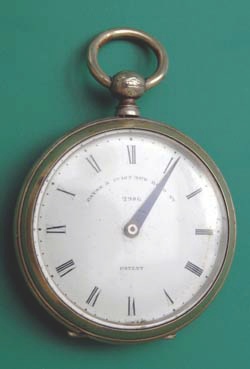
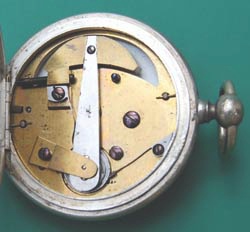
Payne & Co, 163 New Bond Street, London, pedometer no. 2986. Reading to 12 miles by ¼ miles it has a gilt brass/silver plated pair case. Dated inside inner case to 1846? (difficult to read). William Payne patented the type of mechanism shown in which the pointer is advanced by the motion of the internal weight in 1831. No reset mechanism. Adjusting screw (end stop) can be seen to right of top of hinge.
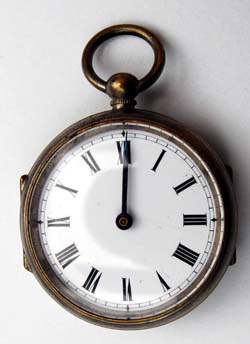
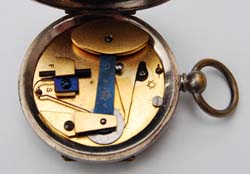
Victorian or Edwardian pedometer reading 0 to 12 miles. Plated brass case with hinged back and glass. Adjusting screw similar to that in the Payne pedometer. Enamel dial. Zeroed by moving the hand. No maker’s name but small Star of David stamped on mechanism back plate. Number 55, above an arrow or letter A, stamped inside case back. 45mm diameter. Gilt brass movement.
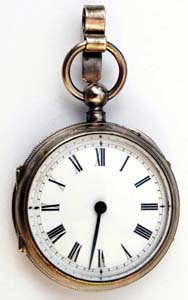
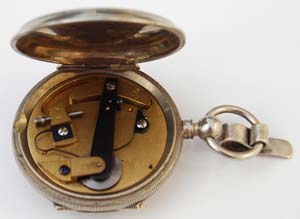
Victorian or Edwardian pedometer reading 0 to 12 miles. Plated brass case with hinged back and glass. Adjusting screw similar to that in the Payne pedometer. Enamel dial. No maker’s name but trade mark of unknown maker on pendulum. 43mm diameter. Brass movement.
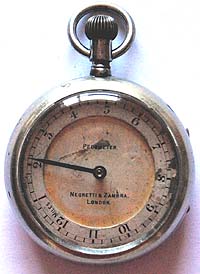
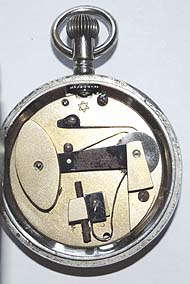
This pedometer is signed Negretti & Zambra, London but they were the retailers as the movement is again stamped with the star of David. The movement is again gilt brass but the case is nickel silver. This one is reset by depressing and turning the ‘winder’ which rotates the chapter ring. Numbers 5 and 24 are stamped inside the case back. It reads to twelve miles by quarters.
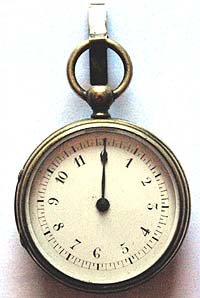
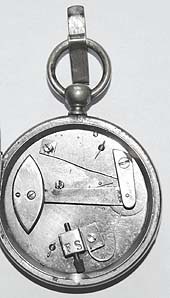
This pedometer is unsigned and has a steel movement. It measures up to 12 miles by eighths. As usual with English pedometers of this period it is adjusted for stride length with a screw inside the hinged case back. The glass is also hinged so that it can be reset by moving the hand.
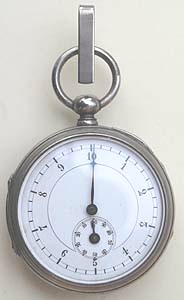
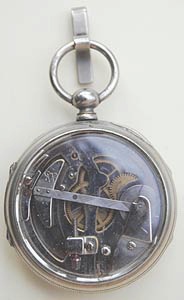
This pedometer with two dials reading to 10 miles by ¼ and to 100 miles is by the same unknown maker as the one above as it has the same trade mark on the pendulum. Probably English and early 20th century. Both the glass front and glass back open, the former to reset the hands and the latter for adjusting the stride length with the screw. The movement plates are polished steel with brass wheels. Nickel plated brass case 45mm diameter.
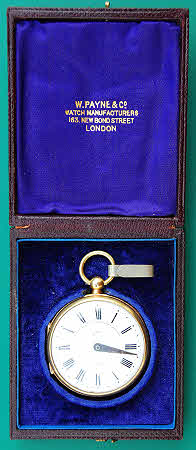
W Payne & Co ladies pedometer no 5054. It has a gilt metal case and is in mint condition. The outer case is covered in morocco leather and lined with blue silk and velvet. It also has its original instruction sheet describing how it is adjusted, how it works with illustrations of the mechanism, and how to reset it by opening the glass and pushing the hand back to zero.
Judging by the serial number it probably dates from 1871.
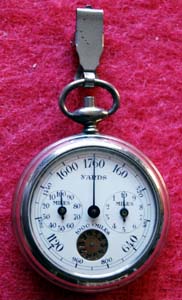
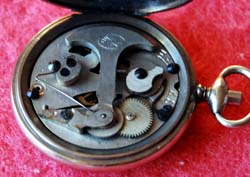
HC, France, Pedometer
The pendulum carries the SL trademark of the Société des Lunetiers. Early 20th century, complete with instruction leaflet. Nickel plated brass case.
The main dial reads to 1760 yards (I mile) by 80 yards. The subsidiary dials and “totalizer” read to 10, 100 and 1000 miles. There is a cam inside the case for adjusting the stride length and a button at the top for zeroing the three dials. To zero the totalizer the glass has to be opened and the totalizer rotated by a pin. Early twentieth century.
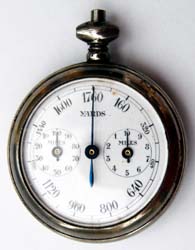
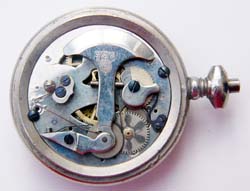
HC, France, Pedometer. The pendulum of this one carries the HC trade mark of Henri Chatelain of Paris. The movement is a slightly simplified version of that in the HC pedometer above as this has only the
0 - 1760 x 80 yds, 0 - 10 miles and
0 - 100 miles dials. Nickel plated brass case with some plating wear and missing ring and clip but in good working order. Early/mid 20th century.
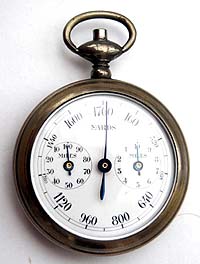
Another HC, France, Pedometer similar to the one above with only detail differences such as finer engine turning on the inside of the case back. Complete with instruction leaflet and in a leather case (possibly not original).
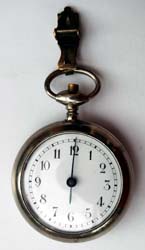
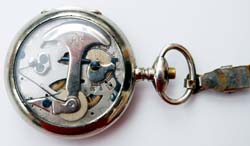
HC, France, Pedometer. Another pedometer by Henri Chatelain, in this case registering zero to 12 miles by ¼ miles. The movement is like the one above except that it has a simpler gear train. Nickel plated brass with hinged and glazed back. Early 20th century.
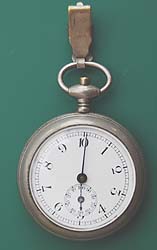
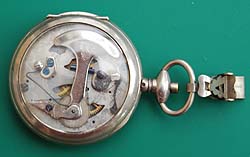
HC, France, Pedometer. Another pedometer by Henri Chatelain, in this case registering zero to 10 miles by 1/10 miles and 0 to 100 miles. The movement is similar to the one below but with an additional gear for the second dial. Nickel plated brass with hinged and glazed back. Early 20th century.
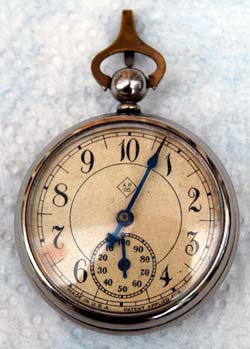
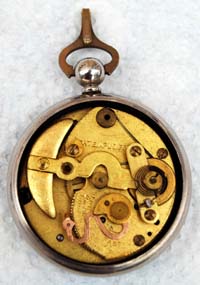
American Pedometer Co (New Haven, Ct) pedometer with patented (see below) stride length adjustment and also knurled screw (centre) to zero the dial. The dial is dirty white card. Early 20th century. The subject of US patents 694,652 (March 4th 1902) and 738,482 (September 8th 1903); the latter clearly shows this movement.
Other versions exist, e.g. named “American” and made by the New Haven Clock Co.
Obtained from the USA.
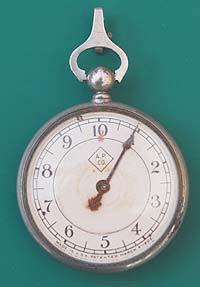
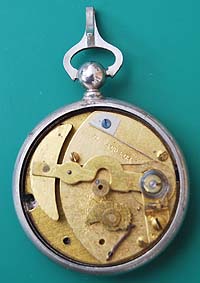
The single dial, 10 mile variant of the American Pedometer Co pedometer. Possibly a very early one as it does not have the W shaped spring featured in the 1903 patent for the stride adjustment cam but has the straight spring shown in patent 718,795 of 20th January 1903.
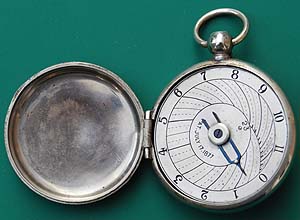
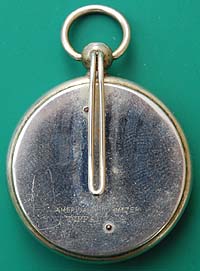
Patent pedometer stamped on the back of the nickel silver case “American Pedometer” and ”Tiffany & Co.” On the face of the dial it is inscribed “Pat. July 17, 1877”. This patent (193224) was taken out by Benjamin S Church of Scarborough, New York,.
He was also granted a second US patent (210096) on November 18, 1878, which actually more accurately illustrates this pedometer.
The pedometer has a number of novel features that were described in these patents. Firstly both the dial face and the pointer (hand) rotate and are driven by differential gears such that the hand rotates very slightly faster than the dial. Secondly the dial is engraved with curved lines to accommodate a wide range of pace lengths. Thirdly the hand can be moved radially on the spindle such that its point touches the engraved curved lines in the correct place for the wearer’s pace length. The pedometer can be reset by manually rotating the dial and hand back to zero at the top of the instrument. It measures up to 12 miles.
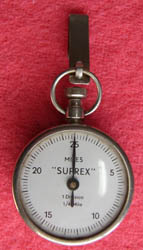
“Suprex” pedometer, nickel plated brass, dating, probably, from the third quarter of the 20th century. Reading 0 - 25 miles, one division equals ¼ mile. Knurled screw at top is for adjusting length of stride. There is a zeroing screw in the centre of the case back. Made in Germany by Kasper & Richter. The same pedometer can also be found branded “Aristo”, other brands and unbranded.
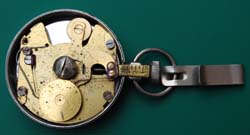
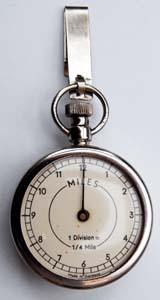
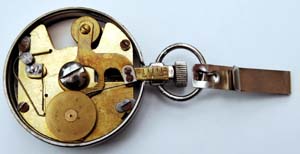
Compass Pedometer No: 968 made in Germany by Kasper & Richter. This is the 12 mile version of “Suprex” shown above - the mechanism is clearly the same apart from some very minor differences, mainly due to the different scale. Obtained from the USA. Complete with original card box.
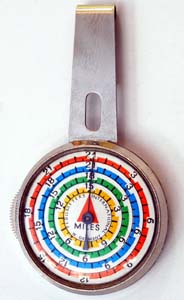
Pedometers International “Littleped” pedometer made in West Germany, 40mm diameter.
Chrome plated metal case with board back. Wheel at left side for resetting to zero.
No stride adjustment; instead it has four scales on the dial (0 - 15, 18, 21, & 24
miles) and the user had to choose the scale that best fitted their stride length
by first using it when walking over a known distance. Complete with instructions
and card box.
Pedometers International are still in business today selling pedometers (both mechanical
and electronic) map measurers and related instruments by a number of manufacturers.





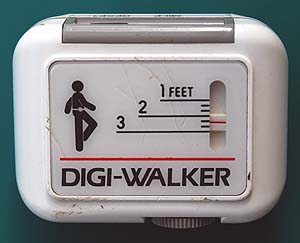
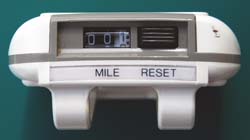
Is this the ultimate development of the mechanical pedometer? A ‘Yamasa, patented, made in Japan’ DIGI-WALKER. Stride length can be adjusted between 1 and 3 feet by turning the grey wheel at the bottom of the unit. On top is the mechanical display with two white on black mile counters and one black on white counting tenths of a mile, maximum reading 99.9 miles. There is also a reset button on the top. Plastic moulded case with integral belt clip.
Bought new by me ca.1990 and still in occasional use.
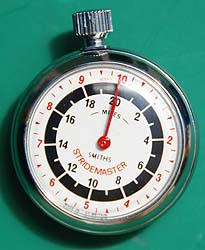
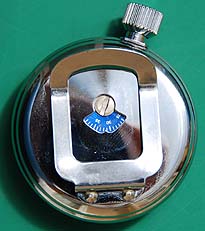
Smith’s Stridemaster pedometer, made in Gt Britain. It has dials reading to 1 mile by tenths and to 20 miles. The winder is used to reset it and the stride length is adjustable through an aperture in the case rear. Made by Smith’s watches. It is complete with its original box in as new condition.
It was also branded Aristo.
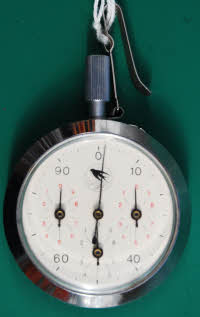
Two late 20th century, Russian, paceometers. The scales on the left hand one read 0-100, 0-1,000, 0-10,000, and 0-100,000 paces. To reset it the wheel at top right has to be moved clockwise and the crown pressed down at the same time.
The right hand one is basically the same except that it only has the first three scales.
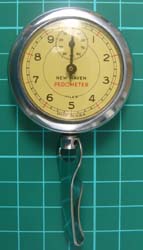
New Haven Pedometer made by the Pedometer Manufacturing Corp, Newark, NJ, possibly in the 1960s. A similar design, with the same ‘No. 230’ model number, was previously produced by the New Haven Clock & Watch Co, CT, which was wound up in 1960. The outer dial reads 0 to 10 miles in ¼ mile divisions, whilst the small dial reads from 0 to 100 miles in tens. There is a zeroing screw in the centre of the case back. There is also stride length adjustment inside the case back. The dial is white under the yellow glazing. The mechanism is very similar to that in the AP Co and New Haven pedometers above. Obtained from the USA.
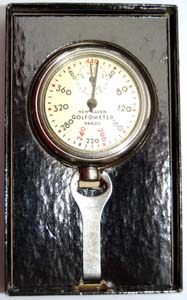
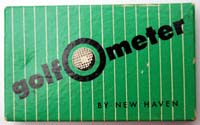
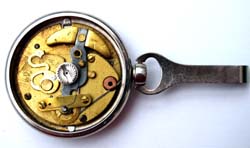
New Haven Clock & Watch Co. No. 232 “Golfometer” in mint condition with original box and instructions. The outer dial reads from 0 to 440 yards in ten yard divisions, whilst the small dial reads to 2½ miles in eighth miles. It has a zeroing screw in the centre of the snap on case back and a stride length adjustment. Another version of the A P Co patented movement. Dates from the late 1950s. Obtained from the USA.
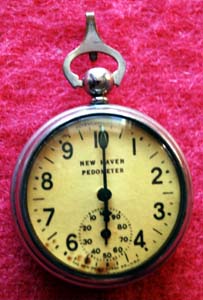
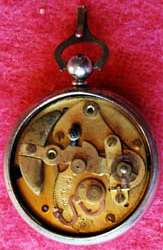
The New Haven Clock Co (New Haven, Ct) “New Haven Pedometer”. This is a later version of the AP Co pedometer seen above with the same basic mechanism. It dates from the mid twentieth century. The main dial reads from 0 to 10 miles by ¼ miles and the small dial reads from 0 to 100 miles anti-clockwise. The dial is white card under the yellow glazing. Obtained from the USA.
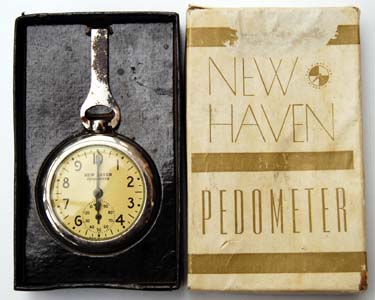
New Haven Clock & Watch Co. No. 230 Pedometer with original box and instructions. The outer dial reads from 0 to 10 miles in 1/4 mile divisions, whilst the small dial reads to 100 miles. It has a zeroing screw in the centre of the snap on case back and a stride length adjustment. Yet another example of the A P Co patented movement. Dates from the late 1950s. Obtained from the USA.
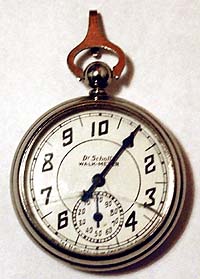
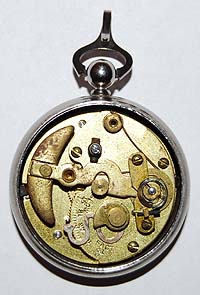
Dr Scholl’s Walkmeter - Dr Scholl’s Med Co Inc, Chicago. This appears to be another product of the American Pedometer Co or New Haven Clock Co.
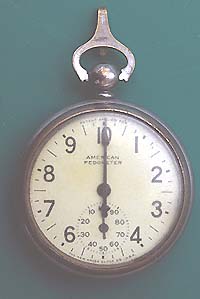
“American Pedometer” made by the New Haven Clock Co, Ct, USA. The mechanism is identical to that shown for the pedometer below. Mid-20th century. The crystal is beginning to go yellow but is not as yellow as that of some of the other pedometers from this manufacturer. Obtained from the USA.
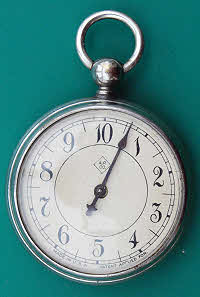
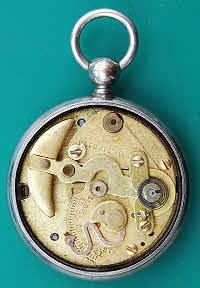
This single dial, 10 mile American Pedometer Co pedometer does have the W shaped spring and the dial numbering is similar to that on the two dial 100 mile type. The ring is unusual for an APCo pedometer and may be a later replacement.
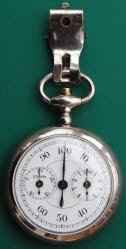
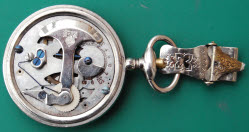
HC, France, Paceometer. Also by Henri Chatelain, this instrument counts and displays paces rather than converting paces to distance. The dials register 0-100, 0-1,000 and 0-25,000 paces. Mechanically it is similar to the HC pedometers shown above. Nickel plated brass with a snap on back. Early 20th century. It would probably have been used by a surveyor.
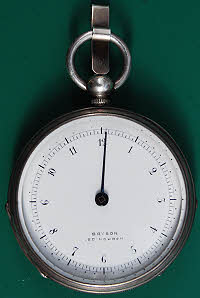
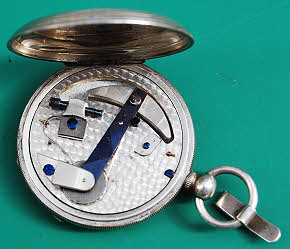
Silver cased pedometer signed Bryson, Edinburgh, late 19th century. The movement back plate is finely engine turned and the pendulum shaft and weight are finely finished.
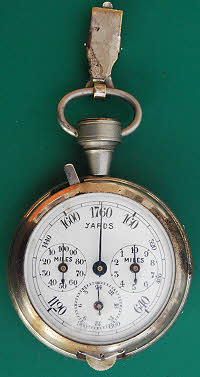
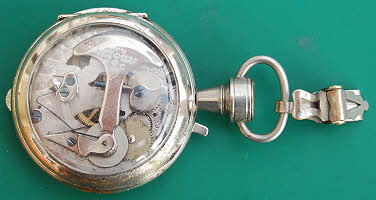
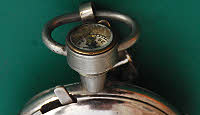
This HC pedometer has 3 dials for 1760 yds, 10 miles and 100 miles. The bottom dial is a map measure reading to 24 inches and there is a compass in the crown. The lever is for zeroing the pedometer, which otherwise has a typical HC movement The case is nickel plated with a hinged glass back.
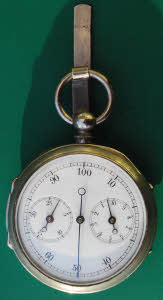
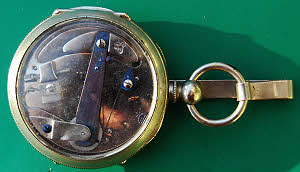
A paceometer by the same maker as the two pedometers above. This counts to 100, 1000 and 25000 paces on the main, right hand, and left hand dials respectively. Both front and back are glazed and hinged for opening. Pace length is set by the screw as usual and the hands are reset to zero by moving the main hand clockwise.
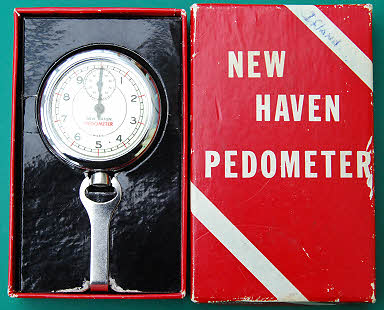
This No 230 pedometer is the same as the one above but has its original box. A gift from a kind lady in the USA.
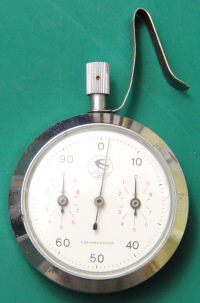
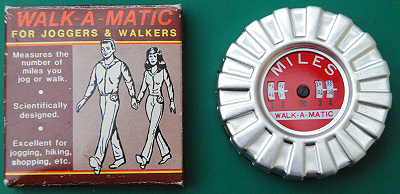
WALK-A-MATIC pedometer made in Japan ca.1950s/1960s. It is complete with box and
instruction leaflet. To cater for different stride lengths it has four windows. It
is reset by depressing the red centre and rotating it clockwise
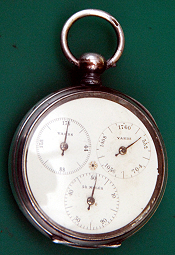
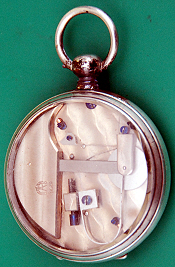
Pedometer stamped on the pendulum with a spring divider trade mark surrounded by
Brevete SDGD with SE & Co underneath. The three dials read to 176 yards, 1760 yards
and 50 miles respectively. Early 20th century.
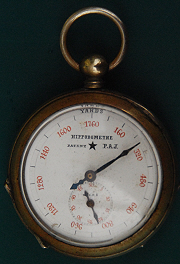
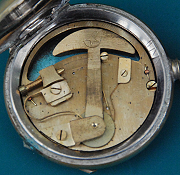
Hippodometre pedometer patent PAJ, no. 728 in case lid, five pointed star trade mark
on pendulum. Enamel dial. Plated brass case. Probably ca.1900 Scales are 0-1760 yards
and 0-50 miles. Hands zeroed by opening glass front and pushing back. Stride adjustment
by screw.





































































